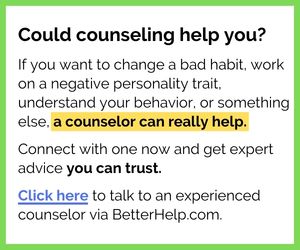You are your own worst enemy. No one can beat you up like you do.
If there was an Olympic sport for having negative thoughts, you would win the gold medal.
Before someone even has a chance to mention one of your faults, you’ve come up with five.
Needless to say, you’ve got a problem.
But you already know that.
Your self-esteem has carried the heavy weight of your negative mindset for as long as you can remember. And being down on yourself every day is exhausting.
You want to stop doing it. Your negative thoughts have disrupted your enjoyment of so many life experiences already, and you don’t want it to continue.
But how can you shut your brain off long enough to step out of your comfort zone to try some of the things you’ve always wanted to try? The things you’ve held back from because your negative way of thinking stopped you in your tracks?
How can you stop looking out for the bad in every situation or person?
How can you change from being a perpetual pessimist to an optimist?
Is it even possible to shut up your inner critic? After all, that naysayer has been yammering on since your childhood.
Having a negative voice in your head that just won’t shut is a horrible way to live.
So, let’s explore some ways to change our way of thinking once and for all.
Speak to an accredited and experienced therapist to help you change the way you think and adopt a new, more positive mindset. You may want to try speaking to one via BetterHelp.com for quality care at its most convenient.
1. Remind yourself that your thoughts are NOT reality.
Many things affect our perception of reality. Our background, education, family, and experiences in life are among those things that color the way we see the world around us.
And what we assume about something or someone may actually be the furthest thing from the truth.
Haven’t you ever disliked someone, only to find out how cool they are after getting to know them? You were convinced they were a complete idiot, only to find out you horribly misjudged them and they are actually pretty great underneath. Once you got to know them, your perception changed.
You see, our thoughts are not reality. At times, they’re not even based on reality, but on our perception of reality. This includes the thoughts we have about ourselves.
Now, that may be a tough pill to swallow. Since you’ve known yourself for a long time, you’re pretty clear on where and how badly you suck. However, your opinions and feelings about yourself are heavily affected by the environment you grew up in and the way you were raised.
Were you raised around criticism, verbal abuse, or in an otherwise toxic environment?
As human beings, we take words to heart. We are quick to internalize critical and negative words, rarely attempting to find out if the feedback is even true. Those words become our truth, used to beat ourselves into submission.
The first step in changing negative thoughts is accepting the fact that your thoughts are NOT reality. Just because you think or feel something, doesn’t make it true.
2. Start a thought journal.
What’s a thought journal, you ask? It’s a secret journal where you write all the negative views you have about yourself.
Why does it have to be a secret journal? Well, for one, it might not be a good idea for someone to stumble upon how truly critical you are of yourself. It would be like exposing your deepest insecurities for the world to see. Remember, our thoughts are not reality. Our opinion about ourselves is probably not how others perceive us.
Second, you’ll be able to write without restraint or fear of exposure.
Divide your journal into two columns. Whenever a negative opinion crosses your mind, write it down in one of the columns immediately. Don’t wait until later, don’t justify it, just jot it down. Write the good, the bad, and the ugly. Don’t overthink it.
When you’re in a better mood or not as pessimistic, read what you’ve written. As you review it, ask yourself the following questions:
a) Is this message really true? How accurate are my thoughts?
b) Would I say this to another person? If not, why am I saying it to myself?
c) What do I get out of having such a negative view?
d) Did I interpret the situation accurately? Is there another explanation for this situation?
For each negative belief, write one to three positive counterarguments. This exercise aims to help you detach from your inner critic and separate its voice from your true voice.
When you’ve done this over some time, you’ll notice the people or situations that trigger your negative thoughts. You can then decide how to handle those triggers.
Hint: Get rid of them. They’re not helping.
Writing helps us to purge our thoughts from our minds. When you see the words on paper or written out, it’s easier to detach, make sense of it (to see patterns or triggers), and move forward (remove or avoid triggers).
3. Practice self-compassion.
It’s easy to be gentle with a baby. It’s not a chore to be kind to a friend. You treat animals gently without any hesitation.
But yourself… you hold to impossible standards, criticize without blinking an eye, work to the bone, not considering your well-being for a second.
In fact, you treat yourself so poorly that if someone else were to do that to a baby or animal, you’d call the police to lock them up. And you’d be right to do so because it’s abuse.
Ask yourself, why is it so easy for you to be nice to everyone else but yourself? Don’t you believe you deserve some compassion?
Resolve to treat yourself like you would a good friend who has poor self-esteem. Be as compassionate with yourself as you would with a child learning how to walk. You’d cheer every step the baby made, quickly picking them up when they fall, and drying their tears with a word of encouragement.
Treat yourself just like that. You are worthy of the same consideration.
We teach others how they should treat us. If they see us treating ourselves like worthless human beings, they’ll fall in line and do the same to us. If you are not kind to yourself, no one else will be either.
Be gentle with yourself.
4. Repeat positive affirmations regularly.
Are you familiar with the phrase “fake it till you make it?” That’s basically what positive affirmations are. You’re saying something positive about yourself, over and over, until you accept it as your truth.
You may wonder, “do they really work, though?”
Well, look at it this way – do you believe all the negative stuff you’ve been thinking about yourself all these years? Of course you do, that’s why you’re here.
Is it possible you’ve repeated a false statement about yourself over and over until you finally accepted it? Then why can’t the same principle apply to positive statements?
Whether the statements are accurate is beside the point. Say them until you believe what you are saying. Say them until they are true. It shouldn’t be difficult. You’ve been doing that all your life, but with no positive outcome.
If you’ve started your thought journal and written one to three counterarguments for each negative point, you’ll have the perfect starting point for affirmations which speak directly to your experience.
But if you’re still on the fence about affirmations or it’s just a little too hokey for you, try adding the word “yet” to the end of your negative thought.
For example, “I’m not a good parent” becomes “I’m not a good parent, yet.” “I’m so shy, I could never stand up before a crowd to give a speech” can turn to “I’m so shy, I can’t stand up before a crowd to give a speech, yet.”
By adding ‘yet’ at the end, you’re implying that you’re on a journey, you’re on your way to becoming, you’re a work in progress. It’s not a finite statement and there’s room for change and improvement. Just the addition of that three-letter word makes a lot of difference.
5. Focus on gratitude.
It’s unlikely that life is so bad that you have absolutely nothing to be thankful for. So make a list and write out the things in your life that you are grateful for.
Everything gets thrown onto that list. Nothing is too small or insignificant to be on that list. Don’t forget the clean air you breathe or the fact that you’re healthy. You have a roof (no matter how small) over your head, food to eat.
With a quick search online, you’ll find many of the “little” things you take for granted are actually not available to everyone on the face of the earth. Some are even considered luxuries.
In some cities, industrialization has taken over so much that the air has become polluted and dangerous for the people breathing it. There are some places where there is no access to clean water.
As you’re writing every single thing you have to be grateful for, you’ll notice your mind clearing and your mood-lifting, almost like magic. It’s extremely difficult to maintain a pessimistic mindset in the light of gratitude.
Review the list regularly to remind yourself of all that’s going well in your life. You might want to try creating a new list each time instead. This will not only bring up additional reasons to be grateful, but it will stop the negative thoughts as you think back on your life to find reasons to be grateful.
6. Have daily negative thought time.
You know how you think negatively all day long? Just any time, anywhere, boom! A pessimistic thought just flies into your head to steal your thunder. You were fine just a minute ago, now you’re fighting back tears, hoping no one notices.
Well, stop that.
Instead of letting the negative thoughts have free rein in your mind to spoil your day, restrict them to a specific and limited ten minutes a day.
Next time a pessimistic idea pops into your head, write it down and forget about it until the allotted time. Restrict ruminating on it until your ten-minute Negative Thought Time.
During those ten minutes, you’re free to think as you wish. Set a timer and engage your inner critic. Throw yourself a pity party. Go all out, cry a few tears, overreact. Once the time is up though, dry your eyes and move on with your day.
Over time, you’ll gain control and negative thoughts will stop dropping by unannounced.
7. Practice coping with criticism.
Even when you know it’s false and coming from a bad place, criticism still stings. Words have the power to hurt, especially when hurled at us with no tact or consideration for our feelings, from someone we respect or love.
Since we’re not perfect, we are all confronted with criticism or negative feedback at one point or another. Many times it’s difficult to accept and/or it’s given in a hurtful manner. Learning how to deal with criticism is an important life skill. Luckily, it is one you can practice.
Because it can come unexpectedly, practicing your response to criticism ahead of time can help you develop the skill to examine it before accepting it hook, line, and sinker. It can stop the criticism from spoiling your mood and keep you from spiraling into a depressed state.
Practice remaining calm, phrases to respond with, and even a quick exit if remaining calm is out of the question.
At a later time, when your emotions aren’t so wrapped up in the situation, you can look at the criticism objectively to see if there is any merit to it. Ignore the messenger or how the message was delivered. Examine it solely to determine if there is any lesson you can take away from it.
8. Practice mindfulness.
‘Being present’ and ‘mindfulness’ are major buzzwords in self-improvement these days. And not without reason. Have you ever noticed how many things in a day you do automatically, with your mind wandering or elsewhere? We get dressed, we drive, we interact with our partners, eat, etc. all while thinking about something or someone else.
Practicing mindfulness allows us to slow down our racing thoughts and focus on only one thing at a time. You’re not clearing your mind or suppressing your thoughts. Rather, you are focusing your mind and learning to accept the unwelcome thought without judgment.
Try mindfulness activities like breathing exercises, walking, or stretching. As you’re going through these actions, listen to your breath and focus on the task at hand. Pay attention to your surroundings. When your mind wanders, bring it back to the present, noting the things that you can hear, see, and feel.
The aim is to gain control over your emotional reactions to circumstances by allowing the thinking part of your brain to take over.
9. Try cognitive restructuring.
Cognitive Restructuring refers to a set of steps that help people notice and change their negative thought patterns.
This technique deconstructs unhelpful thoughts and rebuilds them in a more balanced and accurate way. It teaches you how to examine each negative thought, its usefulness and impact on your life, and how to replace it with helpful ones.
The basic steps to Cognitive Restructuring are:
A) Identify negative thoughts.
With thousands of thoughts flying through our heads throughout the day, many of them negative, it’s hard to identify which ones are harmful and not at all constructive.
This is especially true when these thoughts have been with us for many years. Chances are you’ve stopped seeing them as negative and cannot see how hurtful they are to your self-esteem and mental well-being.
Tracking your negative thoughts helps you to figure out what and who causes you to spiral into such thought processes. When you realize that you’re more susceptible to your inner critic in certain situations, you’ll be able to catch the thoughts and change them (or the situation) before they get the better of you.
B) Evaluate the accuracy of the thoughts.
A critical part of the Cognitive Restructuring technique is evaluating or questioning the accuracy of your thoughts.
Once you’ve noticed the negative thought(s), ask yourself some of the following questions:
- Is this thought based on emotion or facts?
- What evidence supports the accuracy of this thought?
- What evidence disputes the accuracy of this thought?
- How could I test this belief?
- What’s the worst that could happen? How would I respond if the worst happens?
- What other ways could this information be interpreted?
- Is this really a black-and-white situation or are there shades of gray here?
Questioning your thoughts allows you to consider new possibilities that test your perception of reality.
C) Dispute negative thoughts.
In this step, you are gathering evidence for or against your thoughts, assumptions, and beliefs. Now, some of these beliefs have been ingrained in you since childhood, so you’ll need irrefutable evidence to convince your stubborn self how wrong you’ve been all this while.
Make two lists: the first showing evidence to support the assumption, while the second looks at evidence showing the assumption is wrong. Keep in mind that any evidence considered must be fact.
Just to make sure we’re all on the same page, a fact is something that is known to have happened or exists, especially something for which there is proof, or about which there is information.
We’re not talking about your feelings or the opinions/feelings of others on the matter. The evidence is limited to facts alone.
D) Replace negative thoughts.
Review the thoughts and look at the evidence supporting/refuting it and ask yourself the following questions:
- What do you get out of holding on to this belief?
- What does this thought pattern cost you emotionally and practically? How many life experiences has it robbed you of?
- What are the long-term effects of holding on to this belief/assumption?
- How does this thought pattern affect your relationships or the people around you? Have you noticed the same behavior creeping up in your children?
- Is this thought pattern affecting your career or job performance?
By the time you’ve gone through these questions, having completed the previous steps, you’ll have a pretty good idea of the truth of your assumption and the impact it’s having on your life.
Now it’s time to replace the negative thoughts with positive alternatives. This could involve working on areas where you need to improve.
For example, instead of concluding that you are a terrible cook, take a cooking class or watch how to cook something simple on YouTube. Start simple, practice, be patient and over time you’ll improve.
You may also try repeating positive affirmations to replace thought patterns that this process has proven to be false. Instead of saying, “I’m a terrible cook,” say, “I’m not a good cook yet.”
10. Adopt a growth mindset.
The growth mindset is a fairly recent concept that was made popular by Psychologist Carol Dweck’s extensive research into the subject.
It’s a mindset that views intelligence and talent as attributes which can be developed over time. On the flip side is the fixed mindset, which believes that what you have is what you get, or if you’re not good at something, you’ll never be good at it.
Why should you adopt a growth mindset? According to research, the most important factor in predicting a person’s success is not their talent or gifts, it’s their belief system (i.e. do you believe you can do something, or believe you can develop the skills and knowledge necessary to do it?).
Research has also shown that people with a growth mindset have less stress and anxiety, with higher levels of self-esteem.
Aside from being generally less happy and less likely to succeed, a person with a fixed mindset avoids challenges, seeing temporary setbacks as permanent failures. They have pessimistic attitudes and don’t even see the point of trying to achieve a goal. Sound familiar?
Adopting a growth mindset is a continuous process, which includes doing some of the following points:
A) Believe you can change.
A foundational belief for people with a growth mindset is that you are in a constant state of change, you’re a work in progress, you’re not finished yet.
Your inherent talents and gifts are expanding, growing, and developing. Besides that, you’re picking up new skills and talents as you proceed on your journey in life.
You need to believe you can change. Or at the very least, believe that although you may not have the skills right now, you can develop them and learn to succeed. Remove the belief that you can’t do something because you can always learn how to do it.
B) Take ownership.
Stop blaming your shortcomings on circumstances or others. Yes, they may have played a part in your present situation, but ultimately, the buck stops with you. It is your life after all.
The problem has arisen, disaster has come, now what are you going to do about it?
Take ownership.
The next time you blame your situation or circumstance on an outside force, take a step back, own up to your responsibility, identify the lesson, and move forward.
Blaming someone or something else for your situation puts the power concerning the outcome of your life in the hands of a force other than you. It means you are powerless to change and powerless to develop.
That goes against the growth mindset.
Take the responsibility for changing your situation.
C) Be curious.
Instead of being intimidated or embarrassed by how much you don’t know, marvel at it. Don’t be ashamed of it.
No one knows everything. A growth mindset accepts that though there is a lot of unknown information, it can be learned. Someone with a growth mindset is curious, loves learning, and takes steps to close the knowledge gap.
Ask questions, seek information, and don’t be ashamed to learn.
Have a hunger to learn and discover new things. See every opportunity to learn as an opportunity to grow.
D) Allow yourself to fail.
If we’re going to be totally honest, we’d admit that a major reason our inner critics’ voices are so freaking loud is that we’re afraid to fail.
Our inner critic is actually a defense mechanism developed to protect our fragile egos from the dangers of failure.
That’s why you have to allow yourself to fail. Get comfortable failing so you see it’s not as bad as you imagine, so you can learn from the failure, so you can grow from it.
See every failure as a stepping stone on your way to success. Making a mistake is one of the best ways to learn.
No successful person got there by knowing everything and taking the right step at every point, never making a mistake. They’ve all made mistakes and learned from them.
And that’s the greatest benefit of repeated failure, learning how NOT to do what you failed at.
E) Leave your comfort zone.
Growth has never happened to anyone who remained where they are comfortable. No great technological advancement, no cure developed, no feat accomplished where the person was comfortable.
Such development happens in discomfort or because of discomfort.
You need to leave your comfort zone and be comfortable operating outside of it. Growth is on the other side of your comfort.
Leaving your comfort zone allows you to stretch and learn. It’s in that process that you discover a deeper sense of self, grow in confidence, and become more adaptable to change.
F) Focus on effort and not just results.
The end goal is not the only accomplishment along your journey. Every step along the way is also worth celebrating because it brings you one step closer to your goal and one step closer than everyone else who is not moving.
Focus on your effort and not just your results. See the value of your journey. If you’re trying, you’re winning. When you’re fixated on only the result, you’ll miss out on all the things you could learn along the way.
Reward yourself for your efforts, even if you end up failing. At the very least, you’ve learned something and you’re not the same person as when you started.
While focused on the goal, praise your accomplishment in staying the course, in putting in the effort. It’s not just about the goal, the process is equally important.
G) Reflect on areas for self-improvement.
Rather than focusing on your faults, look at them as opportunities for self-improvement.
Don’t overprotect your ego by sweeping your weaknesses under the rug. Doing that will only inhibit your ability to reach success, not to mention make you feel like an imposter.
Acknowledge, reflect, and embrace all your failures.
Then focus on self-improvement and turning your failures into successes. Focus on bettering yourself instead of protecting yourself from failure and embarrassment.
Remember, a growth mindset is one that believes that you’re in a constant state of change. Realizing your areas for improvement is a stepping stone to developing a growth mindset.
You can learn and overcome any failing you may have.
H) Take on challenges.
Don’t run from a challenge. Rather, see challenges that come as learning experiences you would not get otherwise.
Challenges allow you to grow. Therefore, to be free from challenges is to be free from growth, which is the antithesis of the growth mindset.
Run toward challenges. They serve as reminders that you are stronger and more capable than you give yourself credit for. For a mind that sees only limitations, challenges show us that most of the limitations that we think we have are in fact invalid.
Challenges stretch us beyond our perceived capacity. Imagine the pride you’ll feel when you scale it. Even if you fail, you would have still grown beyond your capacity.
11. Seek professional help.
While anyone can use the methods mentioned above for overcoming negative thought patterns, they will be more effective when used with the support of a mental health professional.
A therapist can teach you how to use different techniques to find out where and how your automatic thoughts are biased or illogical. They can help you practice how to cope with criticism.
You can trust a licensed professional to provide you with unbiased feedback because, let’s be honest, not all of us have a support system that actually supports us.
Yes, the financial investment isn’t something to sneeze at. Luckily, there are more affordable alternatives available online these days.
BetterHelp.com is a website where you can connect with a therapist via phone, video, or instant message.
While you may try to work through this yourself, it may be a bigger issue than self-help can address. And if it is affecting your mental well-being, relationships, or life in general, it is a significant thing that needs to be resolved.
Too many people try to muddle through and do their best to overcome issues that they never really get to grips with. If it’s at all possible in your circumstances, therapy is 100% the best way forward.
Here’s that link again if you’d like to learn more about the service BetterHelp.com provide and the process of getting started.
You’ve already taken the first step just by searching for and reading this article. The worst thing you can do right now is nothing. The best thing is to speak to a therapist. The next best thing is to implement everything you’ve learned in this article by yourself. The choice is yours.
*
Changing your mindset, silencing your inner critic, and becoming a more positive person are all difficult tasks.
But you know what is even more difficult?
Living every day battling the voice that says you’re not good enough. Not stepping out of your comfort zone because you’re paralyzed with the fear of a failure that may or may not happen. Seeing your insecurities play out in the lives of your children or affect your relationships with your friends and loved ones.
Don’t let your inner critic get between you and the changes that could make you happier and more successful. Confronting your negative thought process will push you into areas where you feel less comfortable, less accomplished, and more afraid.
It will also push you into less stress, less anxiety, and better self-esteem.
Will it be easy? No.
Will it be worth it? You betcha!
You may also like:
- How To Change Your Outlook On Life: 7 No Nonsense Tips!
- How To Be Positive: 12 Effective Steps To A More Positive Mindset
- How To Stop Ruminating: 12 Tips To Quiet Negative Repeating Thoughts
- 7 Reasons To Shift From A Scarcity Mindset To An Abundance Mindset
- 11 Symptoms Of A Self-Loathing Mindset (+ How To Overcome It)











